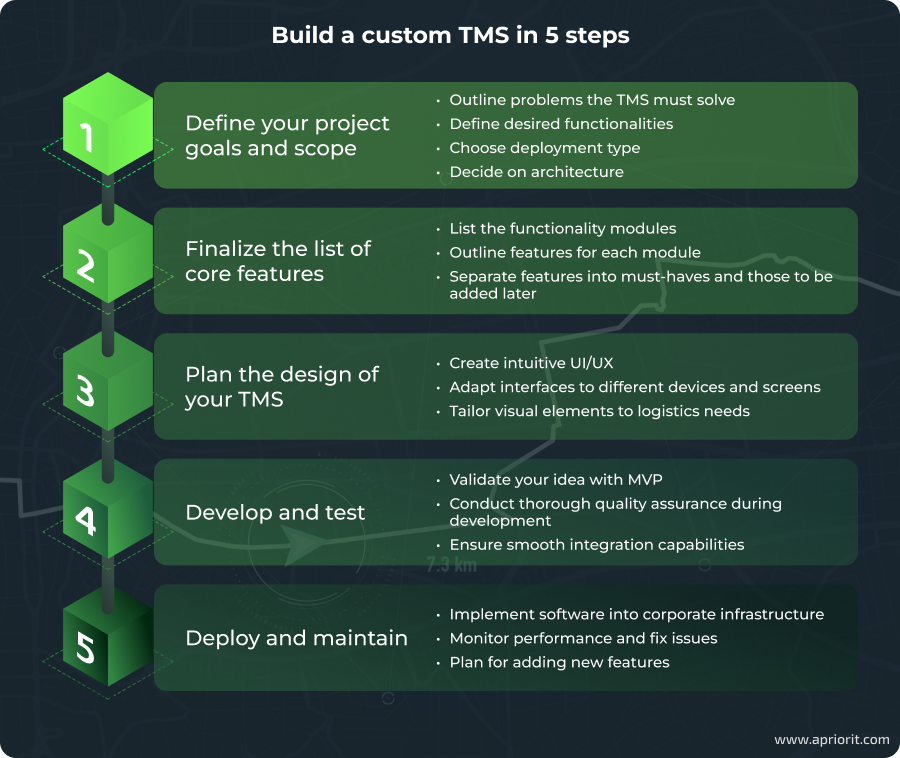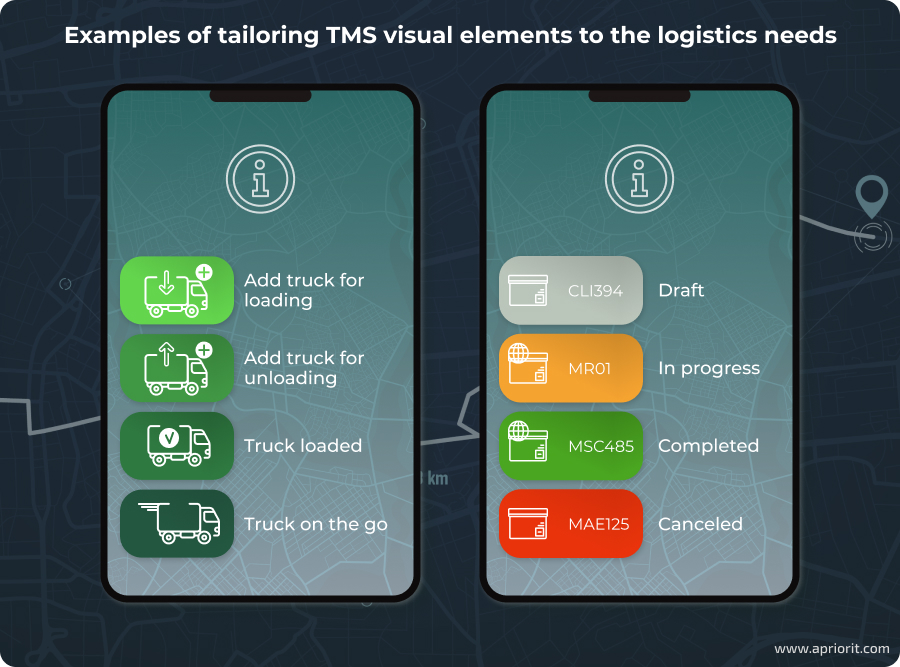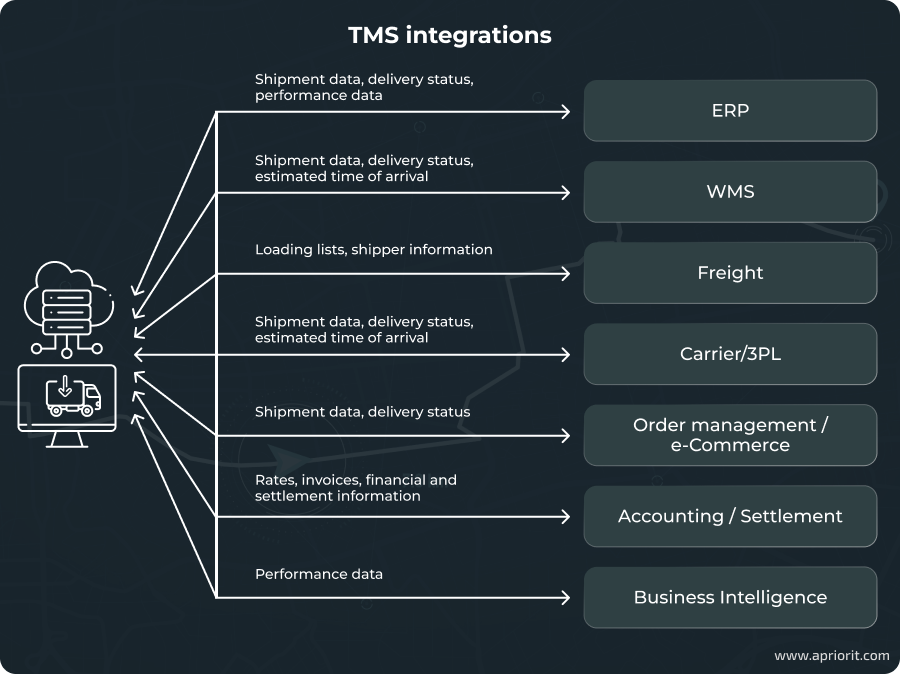Key takeaways
- Logistics companies have diverse operations, regulatory requirements, and service offerings that off-the-shelf TMS solutions can’t cover.
- While custom TMS development requires time and investment, it delivers higher efficiency, better shipment tracking, seamless third-party integrations, and stronger data security.
- Strategically designed TMS products provide companies with the exact functionality they need to overcome unique business and operational challenges.
- Hiring an experienced team for custom TMS development allows you to collaborate with specialists who understand what pitfalls to expect at each project stage and how to overcome them.
Multimodal transportation requires organizations to thoroughly prepare for each order, carefully calculate routes and rates, and act fast in case of force majeure. Thus, an efficient software ecosystem is a must-have for any logistics and supply chain business. And TMS products are an essential element of that ecosystem.
A common issue with commercial TMS solutions is that they often can’t address unique industry challenges, especially since logistics organizations differ significantly from one another when it comes to business vectors and responsibility types. This is when custom transportation management software development comes in handy.
In this article, we discuss the main business benefits of creating a custom TMS. You’ll also find a helpful step-by-step description of how to create your own software and what nuances to keep in mind during each step.
Contents:
What is a transportation management system?
A transportation management system is software designed to help different parties efficiently organize every aspect of the transportation of goods. These systems can either be standalone software products or parts of larger supply chain management systems. As for deployment options, you can find both on-premises and cloud-based TMS options.
The key benefits of transport management systems for logistics organizations include streamlining day-to-day logistics operations and effectively gathering, storing, and processing trade compliance information and documentation.
A TMS usually includes features for:
- Planning, executing, and optimizing shipment deliveries
- Managing transport capacity
- Developing shipment plans and schedules
- Calculating optimal travel routes
- Selecting the most suitable carriers
- Ensuring trade compliance
- Managing contracting, documentation, and billing
- Tracking freight payments
- Tracking shipments and providing status updates
Additionally, some TMS software solutions provide advanced functionalities like delivery cost forecasting, detailed expense analysis, settlements with carriers, and evaluating the performance of transportation operations.
How does a TMS work?
The goal of a TMS is to provide a centralized platform where businesses can plan routes, compare rates, book shipments, track deliveries, and handle other logistics-related processes. To do this, the software leverages algorithms to analyze various factors like costs, distances, delivery speed, and shipment types.
A crucial detail about TMS work is its integration capabilities. To ensure the efficient transportation of goods and provide all parties with up-to-date information, TMS must share data with other management systems. Such systems vary depending on an organization’s type and business needs. A TMS should be able to integrate with the following:
- Customer relationship management (CRM)
- Enterprise resource planning (ERP)
- Warehouse management systems (WMS)
- Supply chain management (SCM)
- Fleet management software
- Payroll software
Who uses a TMS?
Any organization whose operation depends on goods transportation management can improve its workflow with TMS software. The most common users are:
- Manufacturers and shippers ー companies owning or producing goods being shipped via different transportation types.
- Carriers and freight service providers ー companies operating the fleet vehicles that transport goods.
- Third-party logistics providers (3PLs) ー companies outsourcing logistics services within the supply chain. These could include freight brokers, distributors, warehouses, e-commerce providers, and retailers.
With such a variety of organizations working with transportation management systems, it’s obvious that generic TMS solutions aren’t a perfect fit for every business.
Some businesses may be able to compromise on functionality or mix several solutions and services that overlap and duplicate each other in some form. While less efficient, this option may be more affordable and time-saving at the moment, especially for small businesses.
However, there are cases when the most cost-efficient and sustainable solution, in the long run, is to invest your resources in developing a custom transport management system, striving to achieve better flexibility and meet unique industry challenges. In the next section, we analyze the main reasons you may want to consider this option.
Looking to build software for logistics?
Let Apriorit’s skilled developers create a solution to streamline your operations, improve visibility and control, and get real-time actionable insights.
Why invest in a custom TMS? — Business benefits
Businesses are hesitant about investing in custom development for many reasons, from the heavy financial commitment required for such a project to the prolonged delivery of the ready product. However, there are benefits associated with transportation management application development that outweigh those hesitations. Adding new features and customizing existing ones for off-the-shelf solutions can also be costly without any guarantees they will work as intended. Not to mention that with one-size-fits-all software, you also have to pay for unnecessary features you don’t use.
Let’s briefly explore the main reasons you should consider developing a custom TMS and highlight the benefits it could bring to your business.

1. Meet unique business needs. Businesses work with different types of transportation, logistics, and custom operations, as well as process different types of data and documentation — all depending on their location, industry, and operational specifics. The capabilities of off-the-shelf solutions are usually limited, so they can’t cover unique, non-trivial variations. In this case, designing a custom TMS can help you tailor your software’s functionality to your specific processes, data types, delivery channels, transport types, etc., with no exceptions.
2. Increase operational efficiency. Off-the-shelf software often provides features and workflows that suit multiple types of logistics businesses in order to target a wider audience. And while some organizations find those workflows helpful, others may find them unnecessary and time-consuming or, on the contrary, lacking in important details. A TMS designed for your organization’s workflows can give your employees exactly what they need — significantly improving transportation planning, optimizing inventory management, and streamlining other operations. A well-tailored TMS enhances the user experience, allowing employees to automate manual processes and eliminate inefficiencies.
3. Improve shipment traceability. Off-the-shelf TMS solutions are unlikely to provide all the features, integrations, and transport types your company needs. Your team could try deploying several logistics solutions, but with multiple software products, it becomes challenging to centralize shipment management. A custom TMS can ensure the support of the exact transportation types your business works with, update this list if needed, and provide advanced features. For example, your team could get real-time updates by implementing tracking technologies like GPS, IoT sensors, telematics devices, and RFID tags. Thus, a tailored solution would allow your employees to achieve better shipment visibility with a single TMS product.
4. Achieve advanced scalability. Although off-the-shelf TMS solutions usually offer different scalability opportunities, changing the scalability plan requires additional expenses. Your system administrators must also be extra careful because configuring changes in SaaS solutions can be tricky on the client side. When thoughtfully designed, a custom TMS can handle increasing volumes of shipments and adapt to your business growth. With tailored software, your employees can easily add new carriers, warehouses, and distribution centers as you expand your client base and shipment capabilities. A highly scalable custom TMS allows for efficient management of transportation operations while maintaining service quality and minimizing disruptions.
5. Integrate specific solutions. Industry-specific commercial TMS providers usually enrich their products with ocean freight tracking data APIs like SeaRates and other software types commonly used among logistics businesses. However, if your organization uses rare or custom IT products (CRM, ERP, WMS, etc.), it can be tricky to find an off-the-shelf TMS that integrates smoothly into your corporate environment without numerous adjustments and extra expenses. When developing your own custom TMS, your software development vendor can take all integration specifics into account and ensure easy TMS integration with all of your solutions. Tailored integration capabilities will provide your employees with fast and secure data exchange within your corporate infrastructure. You can also enable only those third-party integrations you truly need.
6. Enhance data security. With off-the-shelf solutions, cybersecurity measures are usually shared between you and service providers. This leaves your system administrators with limited options for ensuring data and operational security. When building a custom TMS, however, you can ask your software development vendor to include thorough security measures like data encryption, strong password policies, and multi-factor authentication. Going the extra mile with cybersecurity allows you to minimize data breach risks, protect your business’s reputation, retain customers, and comply with security standards and regulations like the GDPR and ISO 27001.
If you’ve decided creating a custom TMS is what your business needs, the next step is learning about the development process and what to expect during it. In the next section, we guide you through a typical workflow for transportation management software creation.
Read also
Developing Custom SaaS Solutions for Transportation and Logistics
Discover how cloud-based platforms can streamline processes, boost efficiency, and cut costs. Read our in-depth article to learn more.
How to build a transportation management system: 5 key steps
The main idea of creating your own transportation management system is to have software that perfectly aligns with the unique business challenges your organization faces. Thus, each custom solution has a unique feature set, which directly influences the TMS software development roadmap. Still, we can outline five fundamental steps that are common when creating any TMS project:

1. Define your project goals and scope
Start by outlining the main operational problems you want your TMS to solve. If your organization already has experience working with TMS products, gather employees’ feedback on what capabilities they lack. Make sure to outline the main functionality modules you need: transportation planning, freight management, administration, etc. Also, list the software your TMS must be able to integrate with.
Once you have outlined your project goals and requirements, the next step is choosing the most suitable deployment option:
- On-premises TMS can help organizations comply with strict cybersecurity and regulatory requirements by ensuring full control over data storage and access. However, these solutions usually lack flexibility and availability while also being hard to manage and scale for your IT team.
- Cloud-based TMS are easier to scale according to changing business needs. They also provide better availability, as employees can access software from different devices. Although cloud-based solutions share data via the internet, your software development vendor can implement robust security measures such as end-to-end encryption, zero-trust architectures, and identity and access management (IAM) to protect sensitive data from threats.
Last but not least, consult with your IT team on architecture type, as it directly impacts long-term scalability, ease of updates, and system flexibility. At Apriorit, we often recommend choosing microservices, as they allow for modifying each module separately without impacting others, making it ideal for complex systems with diverse functionalities like TMS. Monolithic architecture, while often faster to develop and deploy initially, can lead to scalability challenges. Any modifications require updating the entire system, thus increasing system complexity and introducing security and performance risks when rolling out changes.
2. Finalize the list of core features
When it comes to choosing features to add, we recommend breaking up the task into picking features for each module separately. This will help you see the bigger picture and spot missing or unnecessary features, as well as help developers better plan their future work.
With a variety of business types within the logistics and transportation industry, functionality modules for TMS can vary significantly. Below, we list a few of the most commonly used modules and features they might include. Please note that depending on business specifics, features might appear in different modules than what we specify here.
- The planning module helps employees plan routes, calculate shipment capacity, and generate essential documents like bills of lading, packing lists, and papers for customs.
- Freight management capabilities allow your managers to organize different freight forwarding operations, like managing orders, contracts, shipping rates, etc.
- The execution module allows you to manage vehicle assignments, monitor shipment status, overview warehouse activities, assign loads, etc. This module can also provide convenient features to efficiently communicate with drivers, 3PL providers, warehouses, and other facilities across the supply chain.
- Administration capabilities allow employees to check incoming invoices and draft outgoing invoices before sending them to the accounting department. Additionally, this module often provides features for claim management and settlements.
- Reporting and analytics are essential for business intelligence, helping management analyze various performance metrics and resource usage to identify bottlenecks and plan relevant improvements.
| Functionality module | Features |
|---|---|
| Planning | Load planning, route planning, documentation drafting |
| Freight management | Carrier rate tendering, contract management, order management, shipment rate management |
| Execution | Booking, fleet management, dock scheduling and yard operations, warehouse operations, load assignments, communication, real-time tracking |
| Administration | Billing, payment tracking, settlements, claim management |
| Reporting and analytics | Performance evaluation, expense analysis, spreadsheet with real-time analytics, reports on fuel usage, shipment volumes, trends in delivery times, etc. |
Pro tip: If you decide to build a cloud-based TMS that’s not for internal use only, you might also want to consider creating a customer portal connected to your software. This type of web app provides your customers with delivery status updates so that they don’t have to call or write emails. You might also want to add a digital assistant (a chatbot) to help customers receive immediate responses about shipment information.
Once your team finalizes the list of features, consider outlining the must-have ones to plan their creation and implementation into the first software version. This way, your team can deliver a working solution for your employees faster and start gathering feedback on core functionality.
Related project
Developing a Warehouse Drone Management System: Use Cases, Architecture, Key Technologies
Learn about the role of drones in warehouse automation, the key elements of such systems, and the technologies required to develop this solution.
3. Plan the design of your TMS
Creating a UI/UX design for a custom TMS software is a tricky task. You must make sure that your future software will not only be efficient but also intuitive for your employees. To ensure that your TMS interface facilitates user productivity even as a highly multi-functional solution, your development team should:
- Clearly understand the roles and responsibilities of different user groups
- Group related features and data
- Prioritize the data that’s accessed most frequently
- Add onboarding tools like contextual tips and user guides
If you develop a cloud-based TMS, make sure your team has adapted interfaces to different devices and screens. This will help your employees perform working tasks efficiently even when they aren’t in the office.
An important detail of delivering truly custom and easy-to-use solutions is tailoring visual elements that make sense to industry insiders. For example, designers can use color coding to highlight task statuses. You can have your software display draft orders in light blue, current orders in dark blue, finished orders in green, and denied orders in red. Another example is using truck, ship, and train icons for buttons that add vehicles to transport certain orders. Last but not least, plan to implement maps that can give your employees a comprehensive picture of route alternatives when planning shipment deliveries.

4. Develop and test
During this step, software engineers start developing the future product according to the established roadmap with prepared features and designs. At Apriorit, we recommend first building a minimum viable product (MVP) prior to full-scale software development. This will help you validate your TMS idea, see how your end users like the core functionality, and detect and fix issues before enriching your solution with additional features.
Make sure your software development vendor also offers comprehensive quality assurance services. Rigorous testing is crucial to ensure smooth TMS operation, protect sensitive data from leaks and loss, and eliminate vulnerabilities. Apart from commonly used performance testing, you also might want to conduct security testing, especially if the countries your organization operates in have strict regulations and laws regarding customer data safety.
Since transportation management systems must be able to easily and securely share data with other corporate software, this makes integration capabilities a top development priority. Whether the solutions you use provide APIs for third-party integrations or your team has to develop custom ones, make sure your developers use best practices for secure API configurations.

5. Deploy and maintain
During TMS deployment, your team must pay attention to the smooth implementation of new software into corporate infrastructure, making sure it integrates well with the organization’s environment. Consider performing data migration in several iterations to minimize the risk of data loss.
Once the TMS is deployed, gather feedback from employees to adjust the software according to user needs. Your development team will address reported issues and fix bugs over time while keeping the software operational.
During the support and maintenance phase, you can also request additional features, functionality modules, and even separate apps to expand your TMS capabilities. Common advanced improvements are:
- 3D load planning and route optimization
- Real-time shipment monitoring
- Custom mobile app connected to your TMS
- IoT functionality connecting vehicles with devices and sending data to your TMS
- AI-powered features for data analysis and demand forecasting
To get the most out of custom transportation management systems, make sure to choose a software development vendor with relevant skills and rich experience.
Related project
Streamlining Electric Vehicle Charging Support with an AI Chatbot
See how our AI-powered solution enhanced user interactions, automated customer support, and optimized charging station operations — delivering a seamless experience for EV users.

How Apriorit can help you with TMS development
With 20+ years of experience in the software development market, Apriorit has created IT products for different industries and purposes, including logistics and supply chains. We welcome you to leverage our skills and knowledge to turn bright ideas into brilliant solutions.
Whether your project requires building on-premises or cloud-based software, we are ready to help you:
- Keep the entire supply chain connected with an open but secure communication network thanks to custom mobile device management solutions
- Automate warehousing operations with advanced drone management systems
- Enhance track fleet performance with blockchain-powered solutions for supply chains
- Meet any business needs and handle any industry-driven challenges with thoughtfully designed logistics-centred software
The Apriorit team can also assist you with enhancing the TMS solution you already have by adding new features, creating custom APIs for integration capabilities, supporting legacy code, and more. Our seasoned developers will gladly create and implement functionalities based on artificial intelligence, the Internet of Things, blockchain, and more.
Conclusion
A custom transportation management system can help logistics organizations significantly improve business processes and streamline workflows. Working only with relevant, highly-tailored features and functionality allows end users to handle work routines faster and more conveniently than with off-the-shelf software.
However, building your own TMS requires careful planning and knowledge of development pitfalls. It’s crucial to outline all of the features your end users need, choose the most suitable deployment option, develop and test the solution, plan integration capabilities, and more.
Apriorit’s software engineers and QA specialists will gladly help your team navigate all the challenges of custom software development. We are ready to build a scalable and secure TMS and integrate it smoothly into your corporate infrastructure. Our top specialists can also assist with any related stages, from professional business analysis to project management and UI/UX design. If you need help with improving your existing solution, Apriorit’s developers are at your service for software support, maintenance, and new feature implementation.
Unlock the power of custom software for transportation and logistics!
From fleet tracking to real-time analytics, Apriorit is ready to develop a top-notch IT solution to help your organization transform logistics operations, reduce costs, and boost efficiency.



